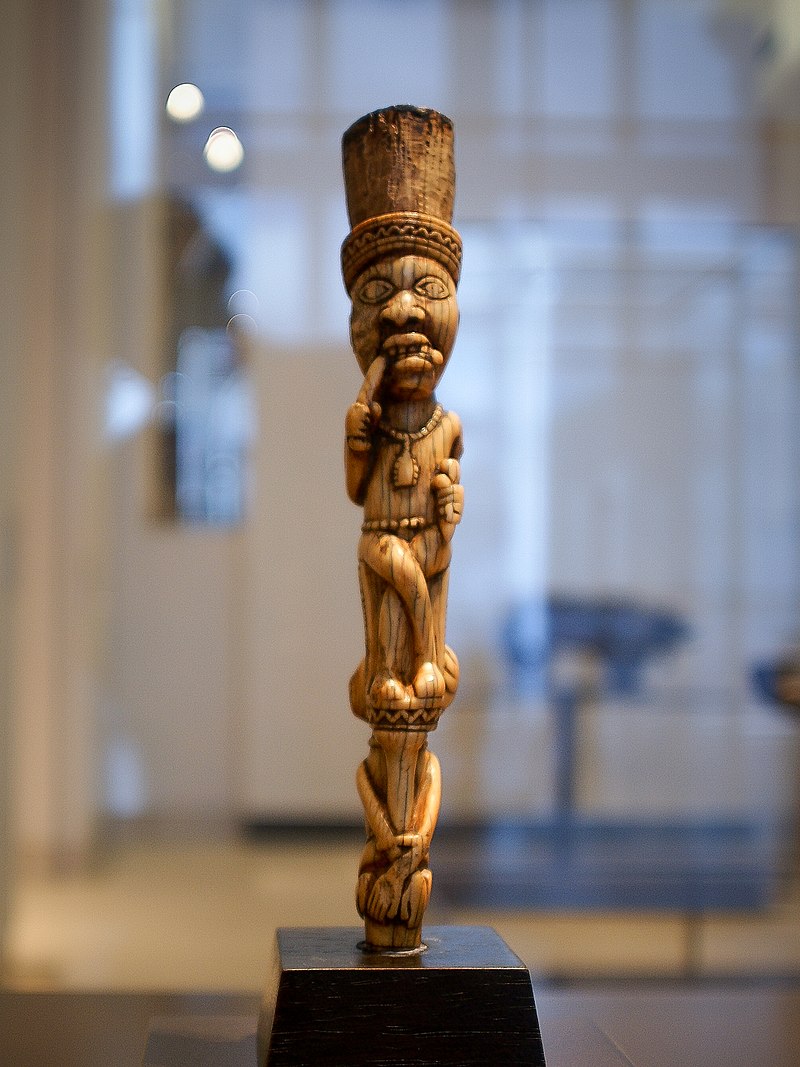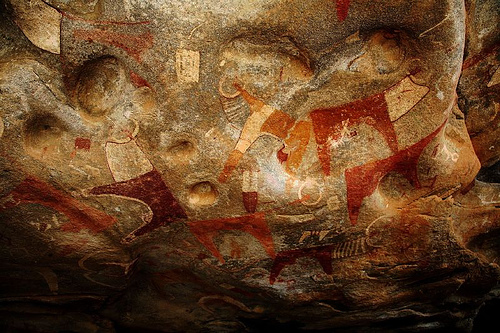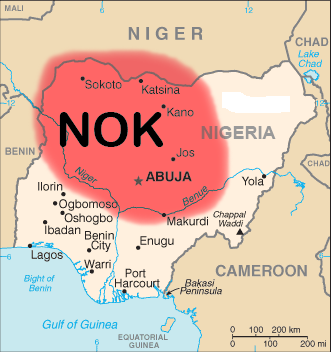Describe the Discovery and Importance of This Piece of Ancient African Art
Art in Ancient Africa
Africa is a huge continent with art and culture everywhere yous expect. It has a long history of making and creating.
Lots of the art in Africa were discovered past Europeans when they colonised parts of the continent.
European artists like Picasso were very interested in African sculptures and forms. African art influenced modern art in Europe. It has e'er had an important part to play in the earth of Art.

African art was discovered by Europeans afterward simply fine art had been made since aboriginal times.
You can acquire virtually these fascinating discoveries here, including magical blacksmiths, ancient stone art, ancient figures from Ghana that have been Dna tested and much more than!
What types of art was there in Africa?
Lots of African fine art is in three dimensions. Y'all volition detect a lot of sculptures (three-dimensional art) every bit well every bit paintings from Ancient Africa.
Of class, we simply know nigh the objects that have survived from ancient times.
There were probably many more (like textiles, cloths and wooden sculptures) which did not survive. This is because the survival of objects (textile civilization) depends on climate and how deep things are buried, as well as what the objects are made from.

African objects could be made from forest, bronze, terracotta and ivory. There are examples of rock fine art from over 6000 years ago which prove that drawings, flat carvings (engravings) too existed.
There are also ancient paintings from Federal democratic republic of ethiopia and drawings on parchment from Egypt which have been preserved very well.
Life-size Giraffes: Pre-historic African Stone art
The oldest art from Africa is institute on rocks and in caves. The people that lived in Niger 6000 years ago went to great problem to draw a life-size giraffe. Imagine how long that took?

There are lots of these art works, carved into rocks or painted in Africa. They often show pictures of horses, giraffe, ostrich, sheep, cattle and other wild fauna.
The British Museum in London has some photographs of this rock art in its drove online.

The oldest images we know of from Africa are from Namibia. They were made 24-27,000 years ago! Some of this fine art could exist even older.
In the Saharan sands in Niger (which is above Nigeria), in a identify chosen Dabous, are some ancient rock art images from every bit early equally 6500 BC.
The oldest paint studios in the world
Cave fine art is found all over Africa. And so, where did these artists go their paint and tools? Luckily we have a discovery that tells us.
Some 43,000 years ago, in Ethiopia, there was the oldest artists' studio of all time! Information technology was plant in a cave in Federal democratic republic of ethiopia in 1929 past ii men called Pierre Teilhard de Chardin and Henry de Monfried.

Pictured in a higher place: Teilhard de Chardin
These clever scholars figured out that these caves had been used every bit artist studios because traces of a material chosen ochre were plant.
It wasn't like today when we just clasp information technology from a tube. This paint was fabricated past grinding downwardly rocks that were total of atomic number 26 in order to make a red-coloured powder.

Some researchers at the university of Barcelona and the Academy of Bordeaux accept found that ancient cavern artists would visit this cave to get a special cherry-red, orange, yellow, brown and greyness coloured paint made from these ochre pigments.
There are also similar rock paint studios from South Africa that date to over 100,000 years old! Practise you recall nosotros could still paint with this paint?
What other coloured dyes are in that location in nature that could be used to paint with?
Nok: the oldest sculptures in Africa
In 1928, a team of miners led past Colonel Dent Immature made an accidental discovery that would modify the way Europe viewed Africa and its art works forever.
These miners plant a terracotta figure of a human head just next to a tin mine in the Kaduna State in Nigeria. In the 1940s, the archeologist Bernard Fagg learned about these discoveries and excavated a site at Nok and Taruga in northern, cardinal, Nigeria.
He found hundreds and hundreds of amazing terra cotta heads.

The Nok civilisation made man heads and figures in terra cotta that are the earliest forms of sculpture made in sub-Saharan Africa.
They date from between 500 BC to 500 AD and some are nearly 3000 years old! When they were first made, they were probably part of larger bodies made from clay.

The researchers at the Metropolitan Museum of Fine art tell us that these figures were modelled from clay in a similar fashion to the way wood is carved.
They believe that this shows us that wooden sculptures existed and so as well and that these wooden sculptures influenced the way the clay terracotta sculptures were fabricated. Of form, no wooden sculptures were constitute.
Why do you call up that is?
Lots of museums own these objects so you lot can often run into them on display if you are lucky enough to visit. Many were looted (stolen) from the sites.
Some are in museums in Nigeria and some are in museums in Europe and the The states.

Archaeologists found that the people who had inhabited this site also forged iron in a very sophisticated way. The people from the Nok site were the first cultures in Africa to really develop iron working.
How did Banana stop up in a sculpture? Aboriginal terracotta figurines from Ghana
In 2010, some archaeologists from Africa and the United Kingdom found some pre-celebrated terracotta figurines from Northern Ghana'southward Koma country. These terracotta figures depicted animals and humans and were dated from the sixth-14thursday Century.
The humans were thought to be ancestors. They had holes inside to put substances and were probably used for healing.
This is quite a mutual theme in African art, where figures of ancestors are fed with food and other substances so that the ancestors help us out in the present with our problems (like illnesses or other troubles).

These clever scholars at the University of Ghana and the University of Manchester tested the figurines for Dna and institute traces of banana and pine within the sculptures. They had to swab inside very carefully because the figures were so old.
Finding banana and pine was quite curious because these things did non grow in that area at all at the time.

Through this discovery, these archaeologists and Dna scientists realised that the people who used these figurines must have traded with North Africa, where they could get these products.
These figures must take been very important to people for them to put such special foreign substances inside.
This just shows you lot what science, archaeology and art tin can tell us almost ancient cultures. It makes u.s.a. wonder what other amazing discoveries are out there to observe.

The magical blacksmith
Archaeologists accept found prove of very old iron works in Ancient Africa (200 BC). They noticed a curious matter. They establish that these iron works were outside of the remains of the main hamlet.
In some societies, blacksmiths were feared and kept split up from the remainder of the hamlet considering their work with transforming metal was seen as a form of magic.
Blacksmiths as well kept their piece of work a cloak-and-dagger to increase the mystery of how things were made.
Blacksmiths were seen equally very powerful people in parts of Westward Africa for their skills in transforming materials from the ground into cute objects.

They fabricated things like musical instruments, tools and weapons, jewellery and other decorations and sculptures.
If you explore atomic number 26 collections in famous museums yous will meet that these beautiful atomic number 26 objects come from all over Africa.
At the Smithsonian in Washington, they had an exhibition just of 225 iron objects that came from nineteen African countries and were fabricated by over 100 unlike ethnic groups.

Atomic number 26 was thought to have divine powers for healing and all sorts of other magical backdrop.
These objects were thought to get more and more powerful with each use. When tools or other iron objects had finished i life, they were not thrown abroad!
They were melted down and the power from their previous utilize was thought to transmit into the brand-new object that the master blacksmiths had magically transformed.
African blacksmiths adult technologies to continue the furnaces just the correct temperature. Africa led the mode with iron age engineering science.

It took a lot longer for Europeans to develop these technologies. Fe age Africans developed bellows that preheated air into the furnaces to keep them betwixt 1150 and 1200 degrees C, the perfect temperature for smelting iron.
Pretty clever stuff!
Quiz Time!

When was the starting time Nok sculpture discovered?
What did scholars find in the oldest paint studio in the world?
How did scholars examination the figurines from Republic of ghana?
What two substances were found in the figurines from Ghana?
How many iron objects were on brandish at the Smithsonian exhibition?
Aboriginal Africa

barnardmorgilizeed.blogspot.com
Source: https://www.coolkidfacts.com/art-in-ancient-africa/
0 Response to "Describe the Discovery and Importance of This Piece of Ancient African Art"
Post a Comment